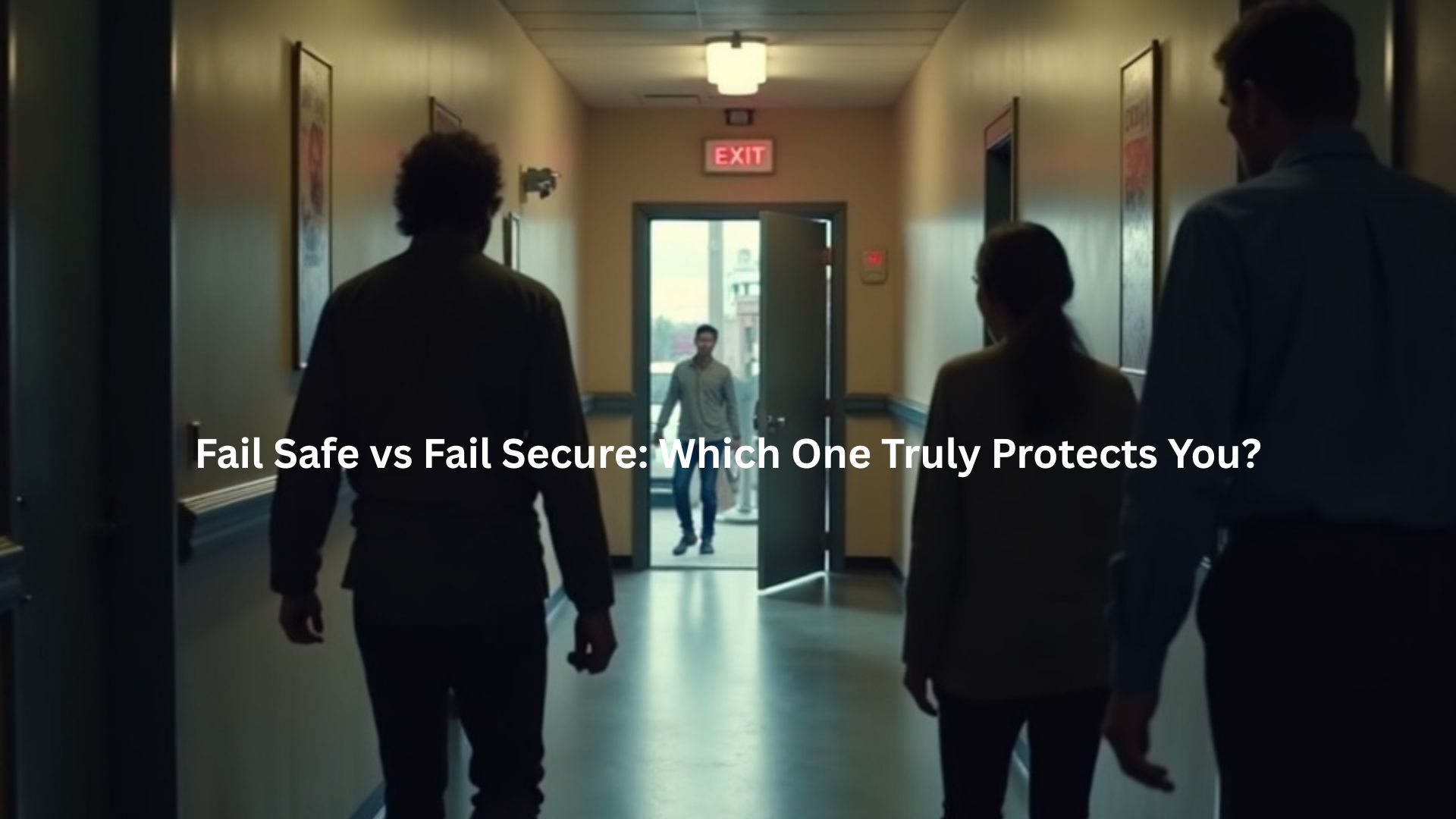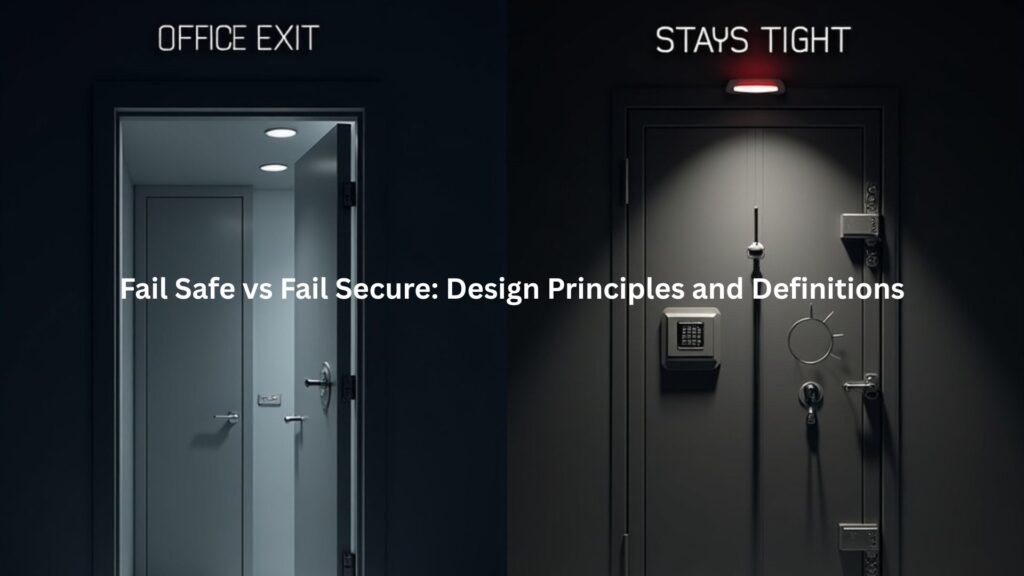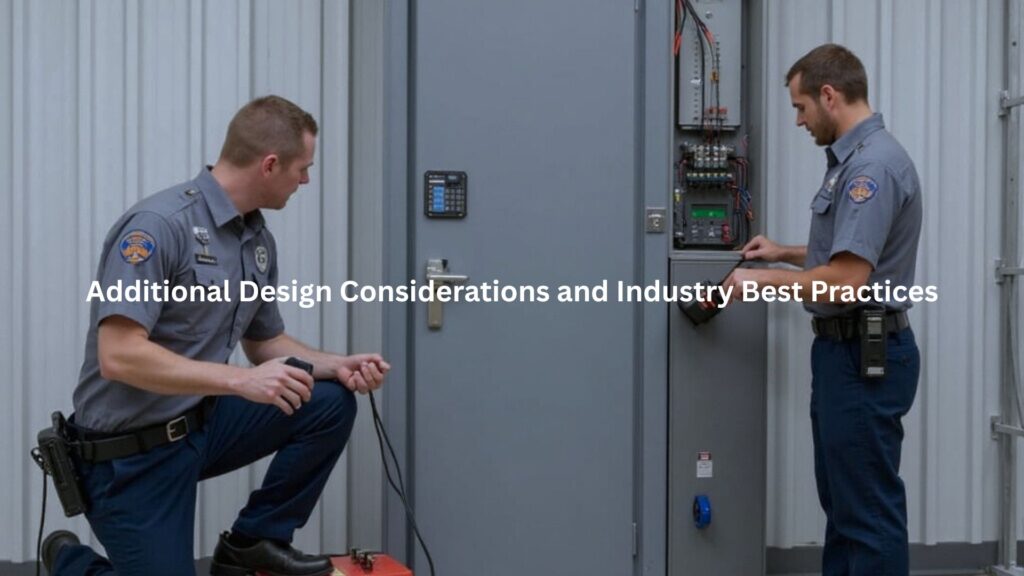
A sudden power cut hit the building one night, showing exactly what matters when lights go dark. The emergency doors clicked open right away – just like they should. Our bootcamp always teaches this stuff, but seeing it in action hits different.
Security teams know the drill: fail-safe systems default to open, fail-secure ones lock down tight. There’s no perfect choice between getting folks out or keeping bad guys away. Still, nothing beats watching real systems protect real people when things go south.
Key Takeaways
- Power goes out? Fail-safe doors spring open automatically – no questions asked
- Fail-secure keeps things locked tight, even during outages
- It’s all about priorities: getting people out vs. keeping stuff safe
Fail Safe vs Fail Secure: Design Principles and Definitions

Fail Safe System Definition and Behavior on Failure
Cut the power at our training center, and something beautiful happens. Every exit door releases its grip, no questions asked. That’s a fail-safe design at work. Our students see this daily – it’s probably the most straightforward security concept we teach, but it never gets old.[1]
The whole setup runs backwards from what most folks expect. These systems actually need juice to stay locked, which sounds weird until you think it through. Walking our facility’s halls, these systems show up everywhere that matters:
- Main entrance doors
- Emergency exits
- Assembly areas
- Training room doors
Fail Secure System Definition and Behavior on Failure
Server rooms tell a different story. Nobody wants those doors popping open just because some squirrel chewed through a power line. That’s where fail-secure comes in – our high-security areas stay locked tight, power or no power.
The team’s got backup keys stashed away (don’t ask where), but that’s not the point. These systems protect what’s inside, no matter what’s happening outside. After running hundreds of bootcamps, we’ve learned some doors just need to stay shut.
Fail Safe and Fail Secure: Primary Focus and Risk Trade-offs
Fail Safe System Focus on Human Safety and Accessibility
Life’s gotta come first – that’s what gets hammered home in every security class here. Fail safe systems aren’t rocket science, they’re just common sense in action. The bootcamp’s front doors work this way, just like most places where people need quick exits:
- Movie theater emergency doors
- Those heavy stairwell doors in tall buildings
- Every mall entrance you’ve ever seen
- Hospital wings (thank goodness)
Sure, there’s a catch. Power dies, doors open, and suddenly the building’s about as secure as a screen door in a hurricane. But when someone’s life is on the line, who’s counting the cost?
Fail Secure System Focus on Security and Asset Protection
Walk past our server room and you’ll notice something different. Those doors stay locked tight, power or no power. The bootcamp learned this lesson early – some things just can’t risk exposure:
- Every data center worth its salt
- Places that keep the really valuable stuff
- Research spaces with sensitive work
- Evidence lockups at police stations
Nobody said security would be simple. These systems mean extra training, backup plans, and monthly drills that make everyone groan.[2] But that’s just how it goes when you’re protecting the crown jewels. The team’s gotten pretty good at working around the hassles – they had to.
Fail Safe and Fail Secure: Typical Use Cases and Examples
Fail Safe System Use Cases in Public and Emergency Settings
Nobody thinks much about door locks until they really need them. Last week’s hospital visit opened our eyes – those massive doors just waiting to spring open if power fails. The bootcamp teaches this stuff daily, but seeing it in real life hits different. These systems hide in plain sight:
- Every mall exit you’ve walked past
- Those school hallway doors that seem too heavy
- Stairwells in fancy hotels
- Most places where crowds gather
A medical supply company showed the team something cool last month – their fancy med cabinets unlock when power dies. Makes sense really. Nobody wants to be the person who couldn’t get to emergency meds because of a dead battery.
Fail Secure System Use Cases in High-Security Environments
The local bank manager gave us a behind-the-scenes tour that changed how we teach security basics. Their vault setup mirrors what we use to protect our most sensitive training gear. Some places just can’t risk leaving doors unlocked:
- High-end security panels (the ones with fingerprint readers)
- Hardened server rooms
- Police evidence storage
- Lab spaces with classified stuff
Every secure door needs a backup plan – that’s lesson one at the bootcamp. The team keeps override keys locked up tight, just in case. Yeah, it’s extra work, but nobody ever said good security would be easy.
Fail Safe vs Fail Secure: Emergency Overrides and Security Considerations
Fail Safe System Emergency Override Mechanisms and Limitations
Watching fail safe locks in action during our training demos always gets students’ attention. There’s something reassuring about their straightforward nature – no power, no lock. Simple as that. But that simplicity comes with some catches:
- Heavy reliance on steady power supply
- Vulnerability during extended outages
- Need for backup power systems
Last week’s campus-wide power failure proved why this matters. Our main classroom doors opened right up (which was great), but so did every other fail safe door in the building (not so great). That’s when everyone understood why we harp on about the importance of secure defaults.
Fail Secure System Emergency Override Mechanisms and Controls
Managing override keys for fail secure systems feels like running a small bank sometimes. Our security team keeps them under strict control, documenting every:
- Key sign-out time
- User identity
- Access duration
- Return confirmation
A funny thing happened during last month’s security audit – we found an override key that nobody could account for. It turned out it was stuck in someone’s desk drawer for “emergencies.” That’s exactly the kind of thing that keeps security folks up at night, and why we now do weekly key checks instead of monthly ones. Because one missing key could compromise everything these systems protect.
Comparing Fail Safe and Fail Secure: Performance and Safety Optimization
Credit: Guardian Save and Lock
Comparative Analysis of Fail Safe vs Fail Secure Behavior Under Power Loss
Power outages tell you everything about how these systems think. Our training lab runs monthly blackout tests, and the difference is striking. Some doors pop right open, ready to let people out. Others lock down tight, like a fortress. Pretty basic stuff, but the implications run deep:
- Fail safe doors spring open (great for emergencies)
- Fail secure ones clamp shut (perfect for protecting valuables)
- Backup power kicks in differently for each type
- Response time varies between systems
Sure makes you think about what matters most in different situations. Last week’s demo really drove this home when half our students got “trapped” in the secure zone during a simulated outage.
Selecting Appropriate Fail Safe or Fail Secure Design Based on Environment
Picking the right system isn’t just about flipping a coin. Working with dozens of clients, we’ve seen how location changes everything. Public spaces need those fail safe exits – nobody wants to explain why people couldn’t escape during an emergency. But then you’ve got places like our secure coding lab, where failing secure makes more sense. The setup usually follows a pattern.
Front entrance? Fail safely. Server room? Fail securely. Sometimes it feels like a game of chess, placing each piece exactly where it needs to be. And yeah, we’ve made our share of mistakes along the way. That’s probably why we spend so much time helping students understand the real-world impact of these choices.
Additional Design Considerations and Industry Best Practices

Integration of Fail Safe and Fail Secure Systems for Balanced Safety and Security
Some facilities combine fail safe and fail secure features in hybrid systems. For example, a door might fail safe for normal exit but fail secure when locked for security. This layered approach provides flexibility but requires careful design and compliance with Secure Defaults & Fail-Safe Design.
We’ve implemented such hybrid systems to meet complex needs, ensuring both safety and security standards are satisfied.
Maintenance and Testing Protocols to Ensure Fail Safe and Fail Secure Reliability
Regular inspection and maintenance are critical, and implementing fail safe defaults ensures systems respond correctly during outages. Training staff on emergency procedures and override use is equally important to avoid mishaps.
Our teams run regular drills and system checks to make sure these locks perform exactly as intended when needed most.
Conclusion
Selecting between fail safe and fail secure isn’t about choosing better or worse, it’s about understanding what matters most in each situation. Safety or security. Life or property. By knowing how these systems behave, their pros and cons, and real-world applications, you can make smarter decisions for your building’s safety and security.
Remember, the right lock design can mean the difference between safe exit and secure protection when everything else fails. Join the Bootcamp
FAQ
What is the fail safe vs fail secure difference in locks?
The fail safe vs fail secure difference is how a lock reacts when power is cut. A fail safe lock unlocks in a power outage, while a fail secure lock stays locked. This behavior shapes door lock safety, access control systems, and secure door access. Electronic locksets like electric strike lock, electromagnetic lock, or maglock fit into both fail safe locking systems and fail secure locking systems. Each choice affects safety locks, security locks, and intrusion prevention locks depending on whether the priority is safe egress lock or secure ingress lock.
How do fail safe locking systems and fail secure locking systems work in a power outage?
Fail safe locking systems unlock when power is lost, making them common for emergency exit locks, fire door locks, or building security locks where safe escape matters. Fail secure locking systems stay locked, giving stronger security priority locks and asset protection fail secure coverage. A fail safe lock power outage ensures egress, while a fail secure lock power outage blocks intrusion. Designers weigh door lock power failure, electric lock failure modes, and power loss locks when balancing safety locks against secure ingress lock needs.
When should you choose a fail safe lock over a fail secure lock?
The choice between a fail safe lock and a fail secure lock depends on building code fail safe or building code fail secure rules. Fail safe applications include emergency exit fail safe, fire safety locks, and cases needing fail safe fire safety. Fail secure applications cover intrusion prevention locks, fail secure security standards, and asset protection fail secure needs. Fail safe emergency planning favors safe egress lock, while fail secure security supports secure ingress lock. Lock system design and door lock power failure concerns guide which locking system design works best.
What role do electric strike lock, maglock, and electronic locking systems play in fail safe vs fail secure locks?
Electronic locking systems like maglock, electric strike lock, and other electronic locksets can work as electric lock fail safe or electric lock fails securely. A maglock fail safe setup unlocks when power is lost, while an electric strike fail secure stays locked. Both lock release system types fit into access control systems, including access control fail safe and access control fail secure. These designs balance emergency exit security, secure door access, fire safety locks, and building security locks depending on fail safe vs fail secure locks requirements.
How do overrides and backup systems affect fail safe vs fail secure locks?
Overrides and backups make fail safe vs fail secure locks more reliable. A fail safe override or fail secure override lets staff control access during power failure door locks events. Backup battery locks keep electronic locking systems running, while a mechanical override lock provides manual release. Fail safe key override and fail secure key override improve door lock safety. Other tools include fail safe remote release, fail secure remote release, fail safe code locks, and fail secure code locks. These fail-safe mechanism and fail-secure mechanism designs maintain lock status fail safe or lock status fail secure.
What are the benefits and drawbacks of fail safe and fail secure locks?
Fail safe lock benefits include easier emergency exit locks, fail safe emergency exit options, and compliance with fail safe safety standards. But fail safe lock drawbacks include weaker power outage door security and limited asset protection fail secure coverage. Fail secure lock benefits include intrusion prevention locks, fail secure fire safety, and dependable fail secure latching under fail secure security standards. Yet fail secure lock drawbacks include fewer safe egress lock options and higher risks in emergencies. Comparing fail safe latching, fail secure latching, and panic hardware choices helps guide decisions.
References
- https://en.wikipedia.org/wiki/Fail-safe
- https://www.tandfonline.com/doi/abs/10.1080/02331888.2023.2203926

